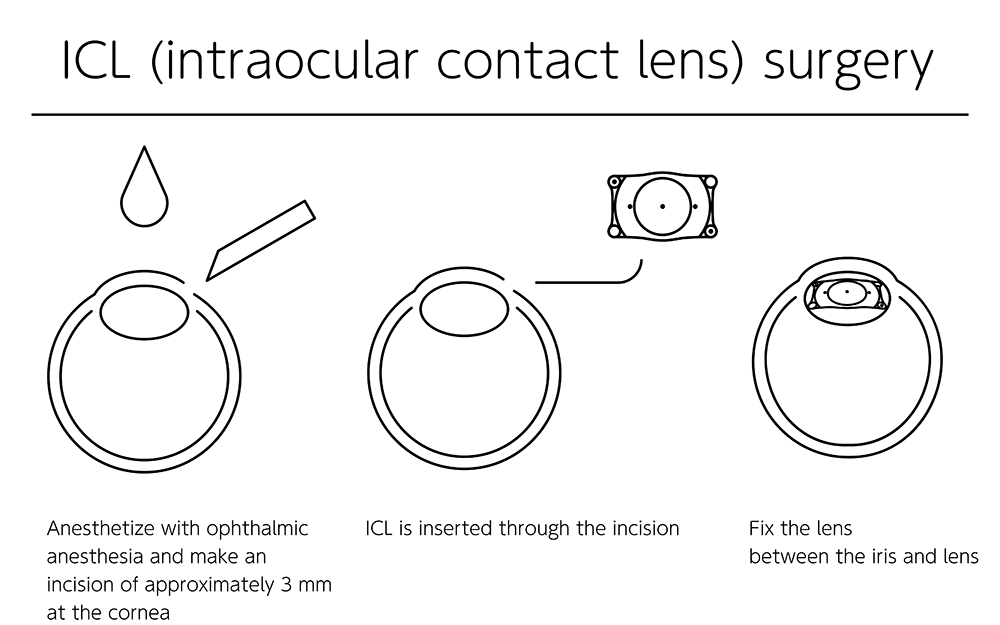You might be thinking about advanced vision correction but feel unsure about choosing between ICL and SMILE in London. Clinical studies show that over 90% of ICL patients achieve 20/20 vision or better, with excellent long-term stability. SMILE surgery shows impressive outcomes for patients with up to -10.00D myopia.
Knowing the unique benefits helps you choose between implantable contact lens and SMILE surgery. ICL surgery boasts satisfaction rates above 95%, while SMILE reduces the risk of post-surgical dryness by a lot. SMILE maintains the cornea’s biomechanical strength. ICL leaves the cornea completely untouched and preserves its natural curvature and integrity. Both procedures deliver remarkable visual quality with fewer side effects than traditional options.
Your specific vision needs and lifestyle will guide the choice between these advanced procedures. SMILE doesn’t need a corneal flap if you have an active lifestyle. This means faster recovery for physical activity and lower risk of long-term dry eye. Precision Vision London’s expert surgeons use advanced technology and personalised diagnostics to determine the best procedure for your unique eyes.

Procedure Overview: How ICL and SMILE Work
ICL and SMILE are great ways to get vision correction through two different approaches. Our specialists at Precision Vision London explain the technical differences that help you make an informed choice.
ICL Surgery Explained: Implantable Contact Lens Behind the Iris
The surgeon places a Collamer lens a special blend of plastic and collagen between your natural lens and iris during ICL surgery. A tiny 2-3mm keyhole incision at the cornea’s edge allows the surgeon to fold and insert this soft, flexible lens. The lens unfolds naturally behind your iris and works with your eye’s existing structures. Modern EVO ICL comes with a central hole that allows natural fluid flow, which removes the need for additional procedures. Both eyes need less than 30 minutes for the complete process.

SMILE Surgery: Small Incision Lenticule Extraction Technique
A femtosecond laser creates a precisely shaped disc (lenticule) within your cornea during SMILE surgery. The surgeon makes a small 2-4mm incision after numbing your eye and removes this lenticule through it. Your cornea’s new shape corrects your vision without creating a flap. The laser treatment takes about 30 seconds, while the complete procedure lasts 10-15 minutes. Natural healing of the minimal incision happens within 1-2 days.
Suitability Criteria: High Myopia vs Mild to Moderate Myopia
ICL works best for higher prescriptions, it suits myopia up to -18.00D and astigmatism up to 5.00D. This makes it perfect for patients with extreme refractive errors. SMILE works well for myopia between -1.00D and -10.00D with astigmatism up to 3.00D. You need to be at least 22 years old with a stable prescription for one year to qualify for either procedure.
Corneal Thickness and Eye Shape Considerations
The biggest difference lies in corneal structure. ICL doesn’t change your corneal structure, which makes it perfect for thin corneas. SMILE needs adequate corneal thickness usually 480μm or more with at least 280μm residual stromal bed thickness. Your anterior chamber depth must be more than 2.6mm for ICL candidacy to ensure enough space for the lens. Complete pre-operative diagnostics at Precision Vision London determine the best procedure for your eye’s unique anatomy.
Post-Op Comfort and Recovery Experience
Recovery is crucial when choosing between ICL and SMILE procedures at Precision Vision London. Patients can plan better for their vision correction experience by knowing what happens after surgery.
Healing Time: 1–2 Days for SMILE vs 2–3 Days for ICL
SMILE patients heal faster, and most can get back to their normal routine within 1-2 days. Their vision improves about 80% just hours after the procedure. ICL patients need 2-3 days to reach similar recovery points, but they see better within hours of surgery. Research shows that 98.5% of ICL patients get vision equal to or better than their glasses prescription within 6 months.
Dry Eye Risk: Nerve Preservation in SMILE vs None in ICL
SMILE affects the eye’s surface and meibomian gland function more than ICL. ICL patients’ dry eye symptoms get better within a month after surgery. This happens because SMILE cuts through corneal nerves, but ICL doesn’t touch the cornea at all. ICL patients’ tear stability usually returns to normal by three months.
Anaesthesia and Intraoperative Comfort
Both procedures use topical anaesthesia to keep you comfortable. Each eye takes less than 30 minutes. You might feel mild discomfort, have watery eyes, or feel sensitive to light after surgery, but these symptoms go away quickly.
Return to Work and Daily Activities Timeline
Office workers can work again within 24-48 hours after SMILE. ICL patients usually start their normal activities within 24 hours. People working in dusty places should wait 1-2 weeks. Here’s when you can restart activities:
- Light exercise: 3-5 days after SMILE, 1 week after ICL
- Swimming: 1 week after SMILE, 4 weeks after ICL
- Contact sports: 2-4 weeks
Post-Op Care and Follow-Up at Precision Vision London
Precision Vision London’s detailed aftercare has follow-up visits at one day, one week, one month, three months, and twelve months. These visits help track your healing and solve any issues quickly. You’ll need yearly eye checks after that, including dilated retinal exams to check lens position.
Visual Quality and Long-Term Outcomes
Patients at Precision Vision London need to know about the long-term visual results when choosing between ICL and SMILE. Our clinical experience backs up what research tells us about these advanced procedures.
Visual Acuity: 20/20 or Better in Over 90% of Patients
Research shows that 93% of ICL patients get 20/20 vision or better. SMILE patients achieve similar results with 90% reaching this standard. ICL shows a slightly better efficacy index of 1.12 compared to SMILE’s 1.06. This measures how well you see without correction versus your previous best-corrected vision. ICL patients report excellent outcomes with 96% seeing better vision quality and 92% feeling satisfied with their results.
Night Vision and Contrast Sensitivity Differences
Each procedure affects vision quality differently. ICL creates fewer higher-order aberrations than SMILE, especially coma. Halos appear more often with ICL (93.5% compared to 54.4% for SMILE), while SMILE patients see more starbursts. ICL patients often see better contrast sensitivity scores than before surgery, especially at spatial frequencies of 6 and 18 cpd.
Stability Over Time: Permanent vs Reversible Correction
SMILE gives permanent results – perfect for patients who want a one-time fix. ICL’s reversibility is a big deal as it means that you can adjust if your prescription changes. Both procedures hit their target correction reliably – 95% of ICL eyes and 90% of SMILE eyes end up within ±0.5D of the goal.
Tear Film Stability and Corneal Health Post-Surgery
SMILE affects corneal nerves, which changes tear production for a while. ICL keeps the cornea intact. This difference explains why tear film returns to normal after one month with ICL, but takes three months with SMILE. ICL patients maintain stable corneal endothelial cell density after surgery.
Lifestyle Fit and Personalisation
Your daily activities play a key role in choosing the right vision correction procedure. Precision Vision London creates recommendations that match your lifestyle needs.

Active Lifestyle: SMILE for Athletes and Physical Jobs
SMILE provides most important advantages for sports enthusiasts and physically active professionals. The procedure keeps more corneal tissue intact without creating a flap, which makes it perfect for high-contact sports. Athletes love the quick recovery timeline, and most can return to light exercise within 3-5 days. Golf and swimming become possible between weeks 2-4, while full-contact sports usually need a 6-week wait. Your corneal stability stays protected against impacts, which removes the risk of flap-related complications during physical activities.
Screen Use and Studio Lighting: ICL for Visual Precision
ICL surgery proves ideal for professionals who work long hours under studio lighting or with digital screens. ICL keeps corneal nerves intact and reduces dry eye problems – vital for people with screen-intensive careers. The ability to fix prescriptions up to -20.00 diopters makes ICL especially valuable when you have severe myopia.
Custom Diagnostics at Precision Vision London
We start with a complete diagnostic process that includes corneal topography, pachymetry, anterior chamber scans, and lifestyle discussions. These tests help us find the perfect procedure that lines up with your vision needs and daily routine.
Real-Life Case Examples from Our London Clinic
A compelling example comes from a 34-year-old interior designer with -10.00D myopia who achieved 20/15 vision through ICL surgery. She no longer needed thick glasses for design work and could see textures and details she had missed before. This change boosted both her professional abilities and personal confidence.
Comparison Table
| Comparison Criteria | ICL | SMILE |
|---|---|---|
| Suitability Range | Myopia up to -18.00D, Astigmatism up to 5.00D | Myopia -1.00D to -10.00D, Astigmatism up to 3.00D |
| Procedure Duration | Under 30 minutes for both eyes | 10-15 minutes total |
| Incision Size | 2-3mm keyhole incision | 2-4mm incision |
| Corneal Requirements | No specific thickness needed; requires >2.6mm anterior chamber depth | Minimum 480μm thickness, 280μm residual stromal bed |
| Original Recovery Time | 2-3 days | 1-2 days |
| Return to Work | Within 24 hours (office work) | 24-48 hours (office work) |
| Swimming Resume Time | 4 weeks post-surgery | 1 week post-surgery |
| Visual Acuity Success | 93% achieve 20/20 or better | 90% achieve 20/20 or better |
| Dry Eye Effect | Minimal (preserves corneal nerves) | More pronounced (affects corneal nerves) |
| Reversibility | Reversible | Permanent |
| Night Vision Effects | Higher incidence of halos (93.5%) | Lower incidence of halos (54.4%) |
| Best Suited For | Screen-intensive work, severe myopia cases | Athletes, active lifestyles, contact sports |
Conclusion
Your unique visual needs, lifestyle, and eye anatomy will determine whether ICL or SMILE is right for you. Both procedures give exceptional results, and more than 90% of patients end up with 20/20 vision or better. SMILE works great if you’re active and need to get back to your routine quickly. ICL, on the other hand, is perfect if you have severe myopia, thin corneas, or spend long hours looking at screens.
These advanced procedures have different recovery times. You can usually get back to your normal routine within 1-2 days after SMILE. ICL takes a bit longer, about 2-3 days for most people. ICL also keeps your corneal nerves intact, which means you’re less likely to have dry eyes compared to SMILE’s effect on tear film stability right after surgery. Both options give you great vision quality, but each has its own advantages. ICL patients often see better contrast, while SMILE holds up better against physical impact. Your daily activities and what you need from your vision should help you pick between these cutting-edge treatments.
Our team at Precision Vision London runs complete diagnostic tests to figure out which procedure will work best for your eyes. We use the latest technology to make sure you get the best results, whatever procedure you choose. We don’t just stop at the surgery – our detailed aftercare programme keeps track of your progress and tackles any issues quickly. While both procedures are way better than older options, they each have their own benefits. When you come to Precision Vision London for a consultation, we’ll explain exactly how each procedure could help your vision and fit your lifestyle. After all, you deserve the best care from a top vision correction centre to help you see clearly.
Key Takeaways
Understanding the differences between ICL and SMILE procedures helps you make an informed decision about vision correction that matches your lifestyle and visual needs.
- SMILE suits active lifestyles: Faster recovery (1-2 days), no flap creation, and excellent stability for contact sports and physical activities.
- ICL excels for severe myopia: Corrects prescriptions up to -18.00D, preserves corneal nerves completely, and offers reversible correction if needed.
- Recovery differs significantly: ICL patients experience minimal dry eye issues, whilst SMILE affects corneal nerves temporarily but heals faster initially.
- Both achieve excellent vision: Over 90% of patients reach 20/20 vision or better, with ICL showing slightly higher satisfaction rates (95%+).
- Corneal requirements vary: SMILE needs adequate corneal thickness (480μm+), whilst ICL works regardless of corneal thickness but requires sufficient anterior chamber depth.
The choice between these advanced procedures should align with your specific prescription strength, corneal anatomy, and daily activities. At Precision Vision London, comprehensive diagnostics ensure you receive the most suitable treatment for optimal long-term visual outcomes.
FAQs
Q1. Which procedure is better suited for patients with very high myopia? ICL (Implantable Collamer Lens) is generally better suited for patients with very high myopia, as it can correct prescriptions up to -18.00D. SMILE is typically recommended for mild to moderate myopia up to -10.00D.
Q2. How do ICL and SMILE compare in terms of dry eye symptoms? ICL surgery tends to have less impact on dry eye symptoms as it preserves corneal nerves. SMILE, while less invasive than traditional LASIK, can still affect corneal nerves temporarily, potentially leading to short-term dry eye issues.
Q3. What is the typical recovery time for each procedure? SMILE patients usually experience faster initial recovery, with most resuming normal activities within 1-2 days. ICL patients generally require 2-3 days for similar recovery milestones, although visual improvement is often noticeable within hours of surgery.
Q4. Are both procedures suitable for patients with thin corneas? ICL is particularly suitable for patients with thin corneas as it doesn’t alter the corneal structure. SMILE requires adequate corneal thickness, generally 480μm or more, making it less suitable for those with very thin corneas.
Q5. How do ICL and SMILE compare in terms of long-term visual quality? Both procedures offer excellent long-term visual quality, with over 90% of patients achieving 20/20 vision or better. ICL may induce fewer higher-order aberrations, while SMILE offers excellent stability against physical impacts, making it ideal for active lifestyles.
Authors & Reviewer
-
 Olivia: Author
Olivia: AuthorHi, I'm Olivia, a passionate writer specialising in eye care, vision health, and the latest advancements in optometry. I strive to craft informative and engaging articles that help readers make informed decisions about their eye health. With a keen eye for detail and a commitment to delivering accurate, research-backed content, I aim to educate and inspire through every piece I write.
-
 Dr. CT Pillai: Reviewer
Dr. CT Pillai: ReviewerDr. CT Pillai is a globally recognised ophthalmologist with over 30 years of experience, specialising in refractive surgery and general ophthalmology. Renowned for performing over 50,000 successful laser procedures.


